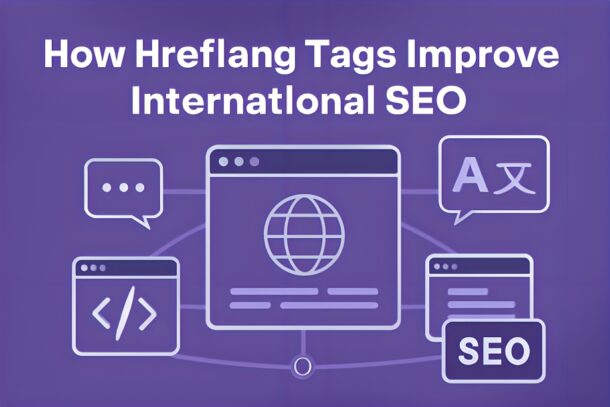Expanding your online presence globally requires more than simply translating content. In fact, businesses that want to rank higher in multiple regions need technical solutions that guide search engines in serving the right content to the right audience. This is exactly where Hreflang Tags come in.
By strategically implementing these HTML attributes, brands can direct search engines toward the correct language or regional version of their website. As a result, users land on the most relevant page, boosting both user experience and SEO performance. Let’s explore how Hreflang Tags can significantly improve your international SEO strategy.
What Are Hreflang Tags?
Before diving deeper, it’s important to understand what Hreflang Tags actually are. These are simple snippets of code added to the A <head> section of a webpage that indicates the language and geographical targeting of a specific page.
For example:
<link rel="alternate" hreflang="en-us" href="https://example.com/us/" />
<link rel="alternate" hreflang="en-gb" href="https://example.com/uk/" />
<link rel="alternate" hreflang="fr-fr" href="https://example.com/fr/" />
This markup tells search engines which audience each page is meant for, ensuring that American users see the U.S. version, while French visitors see the French version.
Why Are Hreflang Tags Important for International SEO?
When your business expands globally, several challenges emerge. Without proper guidance, search engines may:
-
Display the wrong version of your site in certain regions.
-
Confused by indexing duplicate content.
-
Reduce visibility in international search results.
Therefore, Hreflang Tags are not just optional—they are essential. They prevent misinterpretation of your content, reduce bounce rates, and improve the chances of ranking higher across different countries.
Key Benefits of Using Hreflang Tags
Now that you understand the basics, let’s explore the major benefits in detail.
1. Better User Experience
With Hreflang Tags, visitors are automatically served content in their preferred language or country version. Consequently, this ensures a seamless browsing experience and builds trust with your audience.
2. Elimination of Duplicate Content Issues
International websites often have pages with similar content but different regional targeting. Search engines may flag these as duplicates. Thankfully, Hreflang Tags clarify that these are language or region-specific versions, preserving your SEO value.
3. Enhanced Global Visibility
Search engines reward websites that provide clarity. By properly using these tags, your content can appear in the right search results, boosting brand visibility worldwide.
4. Increased Conversion Rates
When users see content tailored to their cultural and linguistic preferences, they are more likely to engage and make purchases. Ultimately, this directly supports your business goals.
Best Practices for Implementing Hreflang Tags
Although powerful, these tags can be tricky to implement correctly. Here are some best practices to follow:
-
Use ISO Codes: Always use the proper ISO 639-1 (language) and ISO 3166-1 Alpha 2 (country) codes. Example:
en-usfor English in the United States. -
Maintain Consistency: Each alternate page must reference the other versions to form a complete loop.
-
Include a Default Version: Always add an
x-defaulttag to guide search engines when no specific match exists. -
Check Implementation: Use tools like Google Search Console or SEO auditing platforms to verify proper setup.
Common Mistakes to Avoid
Even small errors in using Hreflang Tags can affect international SEO. Below are common pitfalls:
-
Mixing up country and language codes.
-
Forgetting reciprocal linking between alternate versions.
-
Omitting the
x-defaultattribute. -
Using incorrect page URLs in the tags.
Therefore, always double-check your code and test thoroughly before going live.
The Role of Hreflang Tags in Multilingual SEO
Global businesses often think translation is enough. However, multilingual SEO requires more than language—it involves cultural targeting. Hreflang Tags allow you to customize not only the language but also the geographical context.
For example, Spanish-speaking users in Mexico and Spain may use the same language but have entirely different search intent. With these tags, you can serve them unique content, tailored to their market.
How Hreflang Tags Support Long-Term SEO Success
In the long run, implementing these tags creates a robust foundation for scaling into new regions. Moreover, they signal to search engines that your website is well-structured, technically sound, and user-focused. As search engines prioritize user intent more than ever, Hreflang Tags give your business the edge in staying competitive internationally.
Conclusion
To sum up, businesses aiming to expand globally cannot afford to overlook the power of Hreflang Tags. By implementing them correctly, companies can improve user experience, reduce duplicate content issues, and enhance global visibility. They form an essential part of any international SEO strategy, offering long-term benefits for growth.
Insprago emphasizes that international SEO best practices and digital marketing services agency support can guide businesses in executing these technical details effectively. By doing so, brands can scale globally while ensuring that users always see the most relevant and localized version of their website.
FAQs About Hreflang Tags
Q1. Who should use these Tags?
Any business with multiple versions of its website targeting different languages or regions should implement them. From e-commerce platforms to service providers, these tags are crucial.
Q2. What happens if I don’t use these Tags?
Without them, search engines may serve the wrong version of your site, leading to higher bounce rates, duplicate content issues, and reduced global visibility.
Q3. How often should I update these Tags?
Update them whenever you add new regional pages or significantly modify your site’s structure. Regular audits are highly recommended.



















